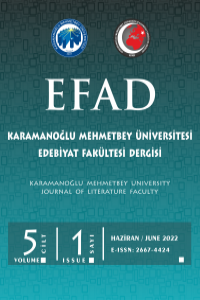MÖ II. Binyılda Eminler Höyük ve Karaman Ovası
Eminler Höyük, MÖ II. Binyıl, Karaman Ovası, Yüzey Araştırması
Eminler Höyük and Karaman Plain in the 2nd Millennium BC
2nd Millennium BC, Karaman Plain, Survey.,
___
- Bikoulis, P. (2012). Revisiting Prehistoric Sites in the Göksu Valley: A GIS and Social Network Approach. Anatolian Studies, 58, 35-59.
- Cohen, H. R. (1970). The Palaeoecology of South Central Anatolia at the End of the Pleistocene and the Beginning of the Holocene. Anatolian Studies. 20, 119-137.
- de Meester, T. (1970). Soils of the Great Konya Basin, Türkiye. Wageningen, Centre for Agricultural Publication and Documentation.
- Dupré, S. (1983). Porsuk I: La cremique de L'age du Bronze et de L'age du Fer. Paris, Editions Recherche sur les civilisations.
- Emre, K. (1989). Pottery of Levels III and IV at the Karum of Kanesh. K. Emre, B. Hrouda, M. Mellink & N. Özgüç (Ed.) Anatolia and the Ancient Near East, Studies in Honour of Tahsin Özgüç içinde (ss. 111-128). Ankara, TTK.
- Fontugne, M., Kuzucuoğlu C., Karabıyıkoğlu, M., Hatte, C. & Pastre, J.-F. (1999). From Pleniglacial to Holocene: a 14C chronostratigraphy of Environmental Changes in the Konya Plain, Turkey. Quaternary Science Reviews, 18 (4), 573-592.
- Forlanini, M. (2017). South Central: The Lower Land and Tarḫuntašša. M. Weeden & L. Z. Ullmann (Ed.), Hittite Landscape and Geography içinde (ss. 239-252). Leiden, Brill.
- Glatz, S. (2009). Empire as Network: Spheres of Material Interaction in the Late Bronze Age Anatolia. Journal of Anthropological Archaeology, 28, 127-141.
- Glatz, S. (2020). The Making of Empire in Bronze Age Anatolia: Hittite Sovereign Practice, Resistance, and Negotiation. Cambridge, Cambridge University Press.
- Gümüşçü, O. (2001). XVI. Yüzyıl Larende (Karaman) Kazasında Yerleşme ve Nüfus. Ankara, TTK.
- Güneri, S. (1989). Orta Anadolu Höyükleri, Karaman-Ereğli Araştırmaları. Türk Arkeoloji Dergisi, 28, 97-114.
- Hansen, C. & Postgate, N. (2007). Pottery from Level III. N. Postgate & D. Thomas, (Ed.). Excavations at Kilisetepe 1994-98, From Bronze Age to Byzantine in Western Cilicia içinde (ss. 329-341). Cambridge, McDonald Institute.
- Kamış, Y. (2018). Karaman Eminler Höyük Yüzey Araştırmaları: İlk sonuçlar. ANMED, 16, 200-207.
- Kamış, Y. (2019a). Karaman Eminler Höyük Archaeological Survey Project: Preliminary Results of 2016-2018 Seasons. S. R. Steadman & G. McMahon (Ed.). The Archaeology of Anadolia Volume III içinde (ss. 231-245). Newcastle upon Tyne, Cambridge Scholars Press.
- Kamış, Y. (2019b). Eminler Höyük ve Karaman Ovası Yüzey Araştırmaları 2018 Yılı Çalışmaları. Araştırma Sonuçları Toplantısı, 36 (3), 511-519.
- Kamış, Y. (2021). Nevşehir Çakıltepe Yüzey Araştırması Erken Tunç Çağı Seramikleri. Seramik Araştırmaları Dergisi, 3, 27-57.
- Kuzucuoğlu, C. (2012). The Rise and Fall of The Hittite State in Central Anatolia: How, When, Where Did Climate Intervene?. A. Tibet, O. Henry & D. Beyer (Ed.). La Cappadoce Méridionale de la Préhistoire À L'époque Byzantine içinde (ss. 17-41). İstanbul, Fransız Anadolu Araştırmaları Enstitüsü.
- Kuzucuoğlu, C. (2019). Geomorphological Landscapes in the Konya Plain and Surroundings. C. Kuzucuoğlu, A. Çiner & N. Kazancı (Ed.). Landscapes and Landforms of Turkey içinde (ss. 353-368). Paris, Springer.
- Massa, M., Bachhuber, C., Şahin, F., Erpehlivan, H., Osborne, J. & Lauricella, J. (2020). A landscape-oriented approach to urbanisation and early state formation on the Konya and Karaman plains, Turkey. Anatolian Studies, 70, 45-75.
- Matessi, A. (2017). The Making of Hittite Imperial Landscapes: Territoriality and Balance of Power in South-Central Anatolia during the Late Bronze Age. Journal of Ancient Near Eastern History, 3 (2), 117-162.
- Mellaart, J. (1958). Second Millennium Pottery from the Konya Plain and Neighborhood, Belleten, 22, 311-345.
- Melllaart, J. & Ann M. (1995). Beycesultan Vol. III, Part II: Late Bronze Age and Phrygian Pottery. Ankara, British Institute.
- Mielke, D. P. (2017). From “Anatolian” to “Hittite”. The Development of Pottery in Central Anatolia in the 2nd Millennium BC. A. Schachner (Ed.). Innovation versus Beharrung: Was macht den Unterschied des hethitischen Reichs im Anatolien des 2. Jahrtausends v. Chr? içinde (ss. 121-144). İstanbul, Ege Yayınları.
- Müller-Karpe, A. (1988). Hethitische Töpferei der Oberstadt von Hattuša: ein Beitrag zur Kenntnis spät-grossreichszeitlicher Keramik und Töperferbetriebe unter Zugrundelegung der Grabungsergebnisse von 1978-82 in Boğazköy. Marburg, Hitzeroth Verlag.
- Newhard, J. M. L., Levine, N. & Rutherford, A. (2008). Least-cost Pathway Analysis and İnter-regional Interaction in the Göksu Valley, Turkey. Anatolian Studies, 62, 87-102.
- Özgüç, T. (1999). Kültepe-Kaniš/Neša Sarayları ve Mabetleri. Ankara, TTK.
- Roberts, N., Eastwood, J. W., Kuzucuoğlu, C., Fiorentino, G. & Caracuta, V. (2011). Climatic, Vegetation and Cultural Change in the Eastern Mediterranean During the Mid-Holocene Environmental Transition. Holocene, 21, 147–162.
- Schoop, U-D. (2006). Dating the Hittites with Statistics: Ten Pottery Assemblages from Boğazköy-Hattuša. D. P. Mielke, U.-D. Schoop & J. Seeher (Ed.). Structuring and Dating in Hittite Archaeology. Requirements – Problems – New Approaches içinde (s. 215-239). İstanbul, Ege Yayınları.
- Schoop, U-D. (2009). Indications of Structural Change in the Hittite Pottery Inventory at Bogazkoy-Hattusa. F. P. Daddi (Ed.). Central-North Anatolia in the Hittite Period: New Perspectives in Light of Recent Research Acts of the International Conference held at the University of Florence içinde (ss. 145-167). Herder&Rome, Studia Asiana.
- Schoop, U-D. (2011). Hittite Pottery: A Summary. H. Genz & D. P. Mielke (Ed.). Insights into Hittite History and Archaeology içinde (ss. 241-274). Leuven, Peeters.
- Tapur, T. (2009). Karaman Şehir Coğrafyası. Konya, Çizgi Kitabevi.
- Türkeş, M. (1996). Spatial and Temporal Analysis of Annual Rainfall Variations in Turkey. International Journal of Climatology, 16, 1057-1076.
- Yayın Aralığı: Yılda 2 Sayı
- Başlangıç: 2018
- Yayıncı: Karamanoğlu Mehmetbey Üniversitesi
Erdal DEMİR, Bayram KANDEMİR, Cengiz TEMÜR
Kaşıkçı Ali Rıza Efendi'nin Kaside-i Münferice'ye Tahmisi
Küreselleşmenin Yeni Medya Üzerine Etkileri
Bir Selçuklu Portresi: Emir İlgazi, Hayatı ve Faaliyetleri
MÖ II. Binyılda Eminler Höyük ve Karaman Ovası
Lauro Olmo’nun “Sardalya Göğsü” Adlı Eserine Feminist Bir Bakış
Karamanlı Âşık Güldiken’in Eğitim Anlayışı ve Şiirlerinde İşlediği Eğitim Unsurları
Mehmet ÇETİNKOL, Mustafa ÇETİNKOL
Karaman ve Konya Ağızlarındaki Arapça Kökenli Olduğu Düşünülen Bazı Fiiller
Sahicilik Kavramının Toplumsal İşlevi Üzerine Rousseaucu Bir Değerlendirme
Vladimir Propp’un Masal Çözümleme Metodu Bağlamında “Sarı Öküz” Masalı Üzerine Bir İnceleme
